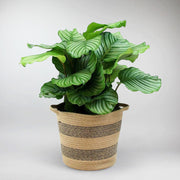Calathea Plants
Calathea Plants
Calathea Orbifolia
Calathea Rattlesnake
Calathea Medallion
Calathea 'Ctenanthe'
Calathea 'Amagris'
Calathea 'Triostar'
With stunning, decorative foliage in shades of glossy green, burgundy, pink and purple, these tropical beauties are some of the most visually stunning houseplants around.
Calatheas need a little more care and attention than other houseplants, however, the tradeoff for being the proud parent of one of these showstoppers is certainly worth it!
Not only is the Calathea beautiful to behold, but it’s also a powerful air purifier, natural humidifier and mood booster. From the splendidly striated silver-green Calathea Orbifolia to the pretty pink pin-striped Calathea Ornata, we’ve got over 15 unique Calathea queens to choose from.
Calathea Plants FAQ
Which Calathea Plant Varieties Do Exist?
We have a diverse range of gorgeous Calathea plants to choose from. They differ from one another in leaf shape and size and ornate leaf design. If you prefer more upright Calatheas with elongated, crinkle cut leaves, choose Calathea Rattlesnake, or Calathea Rufibarba. On the other hand, deep purple Calathea Dottie and spectacularly patterned Calathea Medallion are broader and more expansive, perfect for filling an empty space with some dazzling foliage.
How To Care For The Calathea Plant?
Calatheas are renowned for their somewhat prima donna-like characteristics, but when given proper care, they yield exquisite beauty and wellness advantages.
They thrive in bright, indirect light, abhor direct sunlight, and benefit from a humid atmosphere, which can be attained through misting, a pebble tray, or a humidifier.Maintain the soil slightly moist, watering when the top 5 cm becomes dry, while avoiding waterlogged conditions to avert root rot. It is advisable to use filtered water, rainwater, or tap water left to rest overnight.
These contemplative care routines render looking after Calatheas an excellent stress-relief pastime, providing not only a splendid plant but also relaxation.
Why Are The Leaves On My Calathea Plant Curling?
If the leaves on your Calathea plant are consistently curled (not just curling up at night and opening in the morning), then this is a signal of distress. But don’t worry - we’re here to help you figure out what’s going on! Curling leaves are usually a sign of underwatering or too much direct sunlight.
- If you’ve accidentally let your Calathea's soil dry out completely, give it a good soak until all the soil is evenly damp.
- If the leaves continue to curl after you’ve updated your watering schedule, try using filtered or rainwater as Calatheas can be sensitive to the chemicals in tap water.
- Finally, check whether your Calathea is receiving too much sun, or if it’s not getting enough humidity and adjust conditions accordingly.
How Often Should I Water My Calathea Plant?
Calatheas like their soil to be moist at all times. Water your Calathea plant when the top 5cm of soil feels dry. Lift your Calathea out of its decorative pot and water until you see water come out of the drainage holes. Keep your Calathea elevated until no more water drips out before returning it to its place.
Regular morning misting will also help keep your Calathea glossy and thriving.
In general, your Calathea will need to be watered around once a week in the spring and summer and around once a fortnight in the winter months. However, conditions vary in every home so be sure to check in with your Calathea and see if it’s showing any signs of thirst (drooping, curling leaves, turning brown and crispy etc).
Be sure not to overwater your Calathea as this can cause the roots to rot away.
For even more info on how to care for your Calathea queen and the benefits she offers, check out this handy guide in our very own Plant Care A-Z.
























